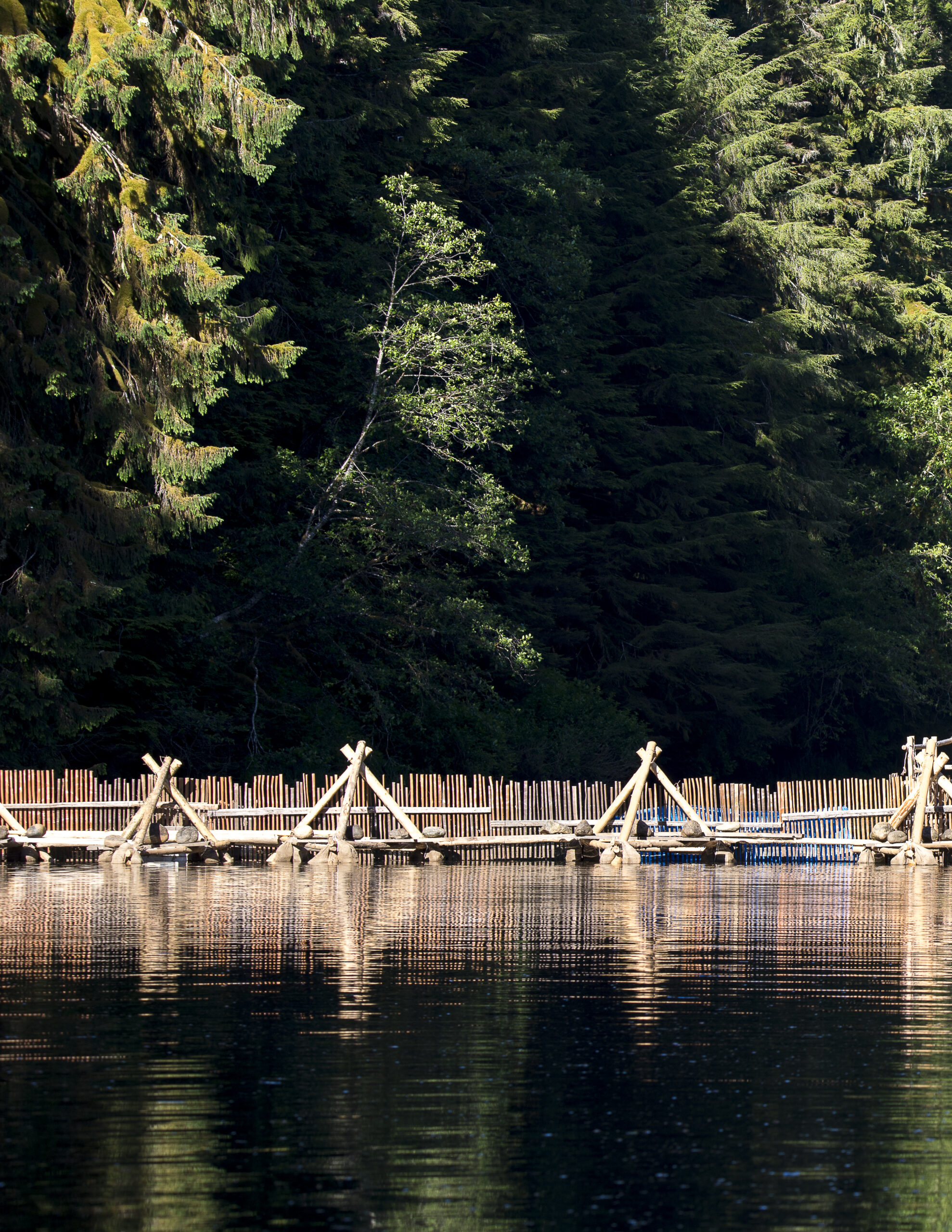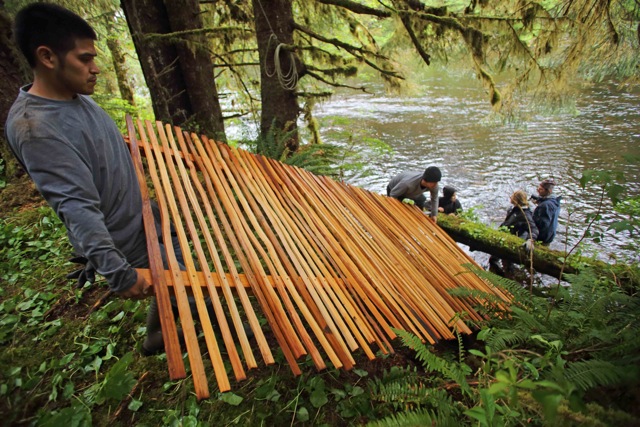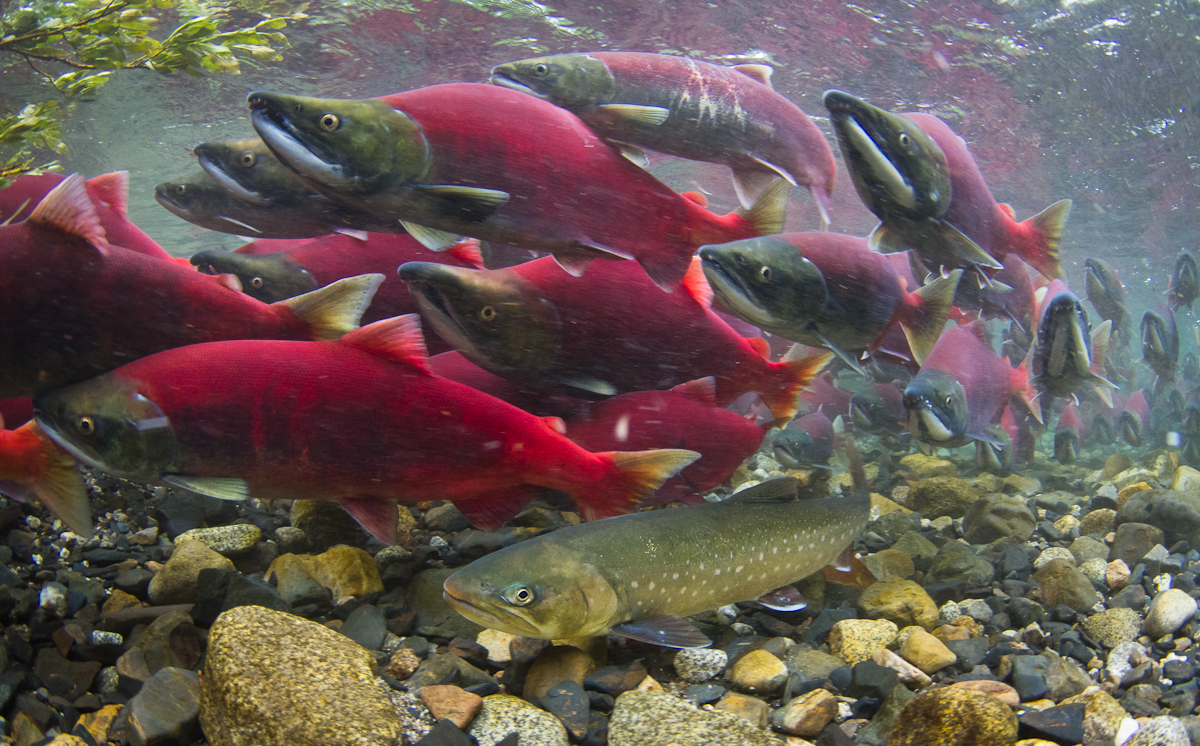
In a Nova Scotia research lab, the last hope for an ancient fish species
Racing against time, dwindling habitat and warming waters, scientists are trying to give this little-known...
On the Nass River in northern B.C., the current spins six fishwheels managed by the Nisg̱a’a Lisims Government. The fishwheels, which carry baskets round and round, are like “ferris wheels for fish,” according to Andrea Reid, a Nisg̱a’a fisheries scientist.
After fish are caught, the baskets drop them into a holding pen submerged in water next to the wheel.
“It’s a friendly way to capture fish because it doesn’t really stress them out,” said Reid, adding that the fish aren’t exposed to air and are rarely damaged.
These fishwheels are just one example of Indigenous fishing technologies that allow for a selective harvest, meaning fish from strong populations can be harvested and those from weak populations can be released. Such technologies were widely used across First Nations territories prior to colonization, when they were banned by the Canadian government. Reid said Indigenous fishing systems were outlawed and destroyed because they were “a source of power” for Indigenous Peoples and “a way for nations to have sovereignty.”
Today, Indigenous fishing technologies are used on a much smaller scale and for various purposes across the province — for instance, the Nass River fishwheels are used for research rather than harvesting — but experts say expanding their use could help save imperiled populations of salmon.
In a new paper published in the journal BioScience, Reid and more than 20 co-authors, including scientists and community leaders, conclude that revitalizing Indigenous fishing management systems and technologies — such as dip nets, fish traps and weirs — could support the sustainable harvest of salmon and strengthen Indigenous governance, unlike contemporary management systems, which have contributed to declining populations.
The authors also note that Indigenous fishing systems are centred on a reciprocal relationship with the environment in which harvesters are also salmon stewards.
“This research is a reminder that if we do things in the right way, as humans, we can continue to have prospering, healthy, rich, beautiful cultures that come from healthy, rich, beautiful ecosystems,” said Spencer La’goot Greening, a member of Gitga’at First Nation of the Tsimshian People and a co-author of the paper.
“The current paradigm has demonstratively failed.”
Doing things the right way is more important now than ever before. This year, Fraser River sockeye returns were the lowest ever recorded. In November, the Committee on the Status of Endangered Wildlife in Canada listed more than half of the 12 chinook salmon populations in southern B.C. as endangered, threatened or of special concern. Only one population is not at risk and three populations could not be assessed due to deficient data.
Salmon face many threats, such as resource development that leads to habitat degradation and warming waters due to climate change. Some scientists estimate thousands of wild salmon die every year from sea lice picked up from salmon farms. B.C.’s commercial fishery usually catched more than a million salmon mid-migration, but in 2019, returns were so low that just 629,000 salmon were caught. (2020 stats are not yet available.)
“The current paradigm has demonstratively failed,” said Will Atlas, lead author of the paper and a scientist with the Wild Salmon Centre. “That’s a travesty. But it’s also an opportunity to reimagine the way we fish.”
Atlas said one of the biggest changes in fishing that took place after colonization was shifting away from in-river fisheries to large-scale, mixed-stock ocean fisheries. In-river fisheries target specific populations, while mixed-stock ocean fisheries intercept many populations. Indigenous Peoples had marine fisheries pre-contact, but they were much smaller than today’s commercial fisheries.
The paper concludes that “there is an urgent need to realign the scales of fisheries with biologically relevant scales,” such as the size of individual salmon runs. The authors suggest doing this by scaling back commercial marine fisheries and refocusing on in-river harvesting. However, they emphasize it’s just as important to make sure in-river fisheries — which can net as many fish as mixed-stock ocean fisheries — don’t overharvest either.
They also recommend fisheries managers support the implementation of selective fishing technologies. Additionally, they suggest policy reform to make harvesters responsible for monitoring and managing fishery impacts and “redistributing some of their catch within their communities.”

A weir on the Koeye River on B.C.’s central coast was built with locally sourced materials and is weighed down with rocks and sandbags. This simple technology comes from millennia of Indigenous salmon management and has provided estimates of sockeye abundance in the Koeye River since 2013. Photo: B Deroy

Sunlight hits the downstream side of the Koeye River weir at high tide. This weir is a cedar fence that spans the river to trap salmon. Photo: B Deroy
Indigenous systems like fishwheels and weirs, which are essentially river-spanning fences, also allow for more monitoring than commercial fisheries, Atlas said. Since these technologies catch salmon in rivers at the end of their journeys in what’s known as a “terminal fishery,” harvesters are “essentially generating information about populations that they’re catching in real time,” he said.
Harvesters can get an idea of the abundance of populations and fish accordingly.
“You can do much more precise, adaptive, in-season management at a terminal fishery than you can do at a mixed-stock fishery, where you don’t know how many fish there were until after the fact,” Atlas said.
He added there are many challenges in shifting from marine fisheries to terminal fisheries, the most central questions being who gets to fish and where — and who decides.
“You can’t assign a commercial fisher with a north central coast area licence a river in a First Nation territory and say, ‘Go fish there with a weir,’ ” Atlas said. “That may create conflicts between First Nations and other users.”
The authors also aren’t suggesting doing away with commercial fisheries completely.
“There is nothing wrong with the existence of [marine mixed-stock] fisheries,” Reid said. “It’s about not putting all of our eggs in that basket and relieving pressure on salmon.”
Since colonization disrupted Indigenous fishing practices, use of these selective technologies today varies across territories.
Many people continue to use dip nets, which operate just as their name suggests. The fisher uses a simple net with a long handle, often in narrow canyons where salmon hug the shoreline. A family will often pass down its dip net site for generations.
The Haíɫzaqv (Heiltsuk) Nation operates a fish weir on the Koeye River on B.C.’s central coast. The weir, a cedar fence that spans the river and guides the salmon to a trap, is being used to monitor the salmon population, so all of the fish that are caught are tagged and released. Atlas participated in the ongoing research project, which is being done in collaboration with Simon Fraser University and the Hakai Institute.
On Vancouver Island, the W̱SÁNEĆ Nation is revitalizing its reef net fishery, a journey that began in 2014 when XEMŦOLTW̱ Nick Claxton built a net for his Master’s thesis at Simon Fraser University. He and other community members went reef net fishing for the first time that year, about a century after the fishery was banned. A second net was launched last August by a group of youth. Reef net fishing involves drawing a central net between two boats and lifting the sides of the net so fish can be selectively harvested or released.
And, last year, the Lax Kw’alaams First Nation, in partnership with the Wild Fish Conservancy, submitted a proposal to Fisheries and Oceans Canada to establish a net fish trap in the Lower Skeena River that would be used for harvesting as well as monitoring. The project is still pending approval.
First Nations have various resources and needs to revitalize their traditional fishing systems. For example, the Nisg̱a’a fishwheels are funded by the Lisims Fisheries Conservation Trust, which was established under the Nisg̱a’a Final Agreement. The treaty established the trust to promote sustainable fisheries and Nisg̱a’a stewardship, with the federal and provincial governments contributing $5.75 million each and the Nisg̱a’a Lisims Government contributing $3 million.

Heiltsuk fisheries technicians Scott Lawson and Robert Duncan move cedar weir panels into the Koeye River. Photo: Grant Callegari
Significant investment is needed to rebuild these systems harmed by colonization, according to Qixitasu, or Elroy White, an archeologist from the Haíɫzaqv Nation. He said more than 300 stone fish traps remain in Haíɫzaqv territory, but none of them is in use. Thousands more dot rivers and streams along the west coast, from Alaska to Washington state.
These traps, which are often at the mouth of the river, are stone walls that are below the surface of the water at high tide. Salmon swim into the trap area, and when the tide lowers, they’re confined in the water behind the trap walls.
White wrote his thesis on stone fish traps, grounded in oral history. People want to revitalize stone fish traps, he said, but the nation faces challenges after decades of disruption.
“To revitalize our stone traps is going to take an incredible amount of money, logistics and support,” he said.
The traps caught many fish, but harvesters would only pick out the ones they wanted to smoke dry, White said. Less oily salmon are better for smoking, and smokehouses would be set up near the trap seasonally. A single family smokehouse would smoke at least 14,000 salmon during the fall, he added, since salmon was so plentiful.
“You’d store [the smoked salmon] in the winter,” he said. “You could store it anywhere — indoors, outdoors, in the rain, in the sun — and it would never rot. You would use it for trade and then use it for food and for ceremonial purposes.”
Seeing the hundreds of fish traps still standing in his territory is significant to White.
“Stone fish traps are a physical reminder of our ancestors’ ingenuity in creating something so simple that helped sustain the salmon population,” White said.
Now salmon numbers are so low, traps wouldn’t catch that many fish, White said.
“Colonization disrupted systems of management that worked pretty darn well for 10,000 years,” Atlas said. “All of us — and salmon and ecosystems that depend on salmon — are suffering the consequences.”
To truly build up Indigenous-led selective fishing projects, he said Fisheries and Oceans Canada will have to “put some money and some teeth behind it.”
“We’ve got to start writing policy … and resourcing communities and fishers to make these kinds of transitions,” he said.
The authors argue that while many modern fisheries in B.C. are “struggling to provide sustainable social, economic and ecological benefits,” Indigenous systems demonstrate benefits in all those arenas.
“Fish are economies for us,” Greening said. “They have been for thousands of years. So highly tuned systems of resource management were necessary for these economies to survive.”
The paper describes how resource management decisions were made at a local level and were geographically specific. In contrast, large commercial mixed-stock fisheries intercept many salmon runs and follow federal government quotas.

B.C. salmon face many threats, including warming waters due to climate change. Photo: J Armstrong / University of Washington
When Fisheries and Oceans Canada introduces restrictions to manage the impacts of mixed-stock fisheries on salmon, those measures can wind up hurting coastal communities by reducing fishing opportunities for locally abundant populations, Atlas said.
“I think a real challenge with our current top-down, bureaucracy-driven fish management is that local people are just fundamentally disempowered,” he said.
Smaller fisheries led by local governments lead to a closer connection with that environment, Greening said.
“Humans are a part of this environment. We can add to it, we can make it diverse and we can make it thrive,” he said.
“The more localized and human relationship you have with the process — that human to ecosystem relationship — the more sustainable it becomes.”
Greening remembers ice fishing with an Elder from Lake Babine Nation in central British Columbia when he was three or four years old. It’s his first memory of harvesting fish.
“It was explained to us that when we’re given a fish, it’s the fish consciously giving itself to us,” he said. “They have agency in this role of providing for us as long as we uphold our responsibilities to them.”
Greening carried those lessons with him. He is pursuing his PhD focused on the connections between language, place-based knowledge and environmental stewardship in Gitga’at territory. When he began his research, Elders didn’t want him to simply write down their answers to his questions.
“They didn’t want me to just learn about what it took to be a Tsimshian fisherman. They wanted me to become that,” he said. “They started teaching me to make nets.”
Fishing, he said, can be “an exercise in reconnecting with your ancestral ways” and can become “a political act.”

Salmon holds cultural significance for First Nations in B.C. Here, salmon is prepared in a smoke house on Heiltsuk territory in Bella Bella, B.C. Photo: Louise Whitehouse / The Narwhal
It’s also an act of ceremony. Along the west coast, the First Salmon Ceremony, is a near-ubiquitous practice “honoring and encouraging the life-giving return of salmon,” the authors describe in the paper.
Following the ceremony, there’s often a short-term moratorium on fishing, allowing the first runs to reach their spawning grounds.
“Indigenous people don’t want non-Indigenous people to just adopt their spirituality, but they want to see these things as connected to something bigger than just profit,” Greening said.
Some Indigenous leaders have called for a moratorium on salmon fishing to save stocks, and, indeed, a study published in September found that closing fisheries in Canada would help rebuild stocks and even lead to economic gains.
At a local level, the Wet’suwet’en First Nation saw Skeena sockeye increase by 50 per cent over three years following nearly two decades of closing or limiting the catch in their food fishery in the Skeena watershed.
They are not alone. Other First Nations, like the Tsilhqot’in, have voluntarily closed their salmon fisheries in recent years, sacrificing their right to fish to conserve struggling salmon.
Greening hopes this paper will end up on the desks of policymakers and members of Indigenous communities to help guide them in restoring Indigenous systems of fishing.
“There’s just that reminder that … our ecosystems don’t have to be crashing in order for us to thrive as humans.”
Get the inside scoop on The Narwhal’s environment and climate reporting by signing up for our free newsletter. On March 17, federal Conservative Leader Pierre Poilievre...
Continue reading
Racing against time, dwindling habitat and warming waters, scientists are trying to give this little-known...

From investigative reporting to stunning photography, we’ve been recognized with four 2024 CAJ Awards nods...

The Narwhal is expanding its reach on video platforms like YouTube and TikTok. First up?...
